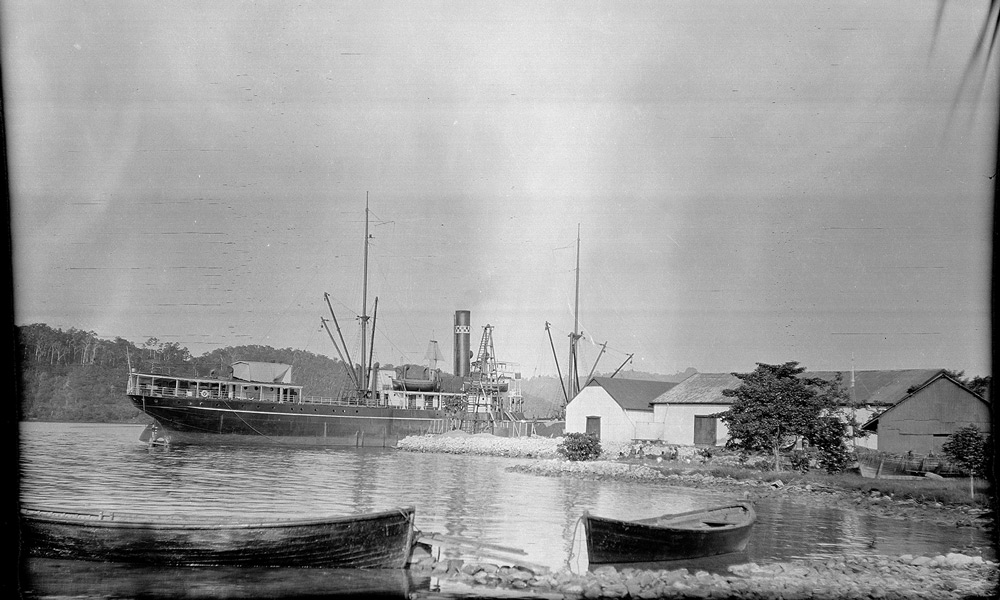THE Daily Commercial News reported the wreckage of Australian steamer Mindini in March 1923. Built in 1905, Mindini would usually sail between Sydney and the Pacific Islands. The ship belonged to Burns, Philp & Co., an Australian shipping line that operated in the South Pacific.
The ship ran aground on its way to Brisbane and was abandoned in the Coral Sea. The newspaper would spend the following days reporting the logistics of bringing the vessel’s passengers and crew back to Australia.
It would later emerge that some of those passengers were the survivors of another maritime casualty, just weeks earlier. Mindini had taken the crew aboard after their own ship caught fire.
DEFIANCE
In late January 1923, American schooner Defiance burned to the water’s edge in the Solomon Islands. The ship’s cargo comprised 500 tons of copra (the part of a coconut used to make oil). The ship was under charter to load the cargo on behalf of Burns Philp. The “island disaster” received attention well outside the maritime media sphere.
“With her holds filled and all ready for sea, a fire broke out on board, and resulted in the total destruction of the ship and cargo,” The Daily Telegraph wrote.
In Brisbane, The Daily Mail reported the eight-man crew of Defiance applied for passage to Australia aboard a passing steamer Mataram, but the ship’s accommodation was full.
“It is stated that the crew will be brought to Australia by the Mindini, which is now in the Solomon Islands,” it wrote.
ABANDON SHIP
Less than two months later, DCN announced Mindini had been abandoned, “a total wreck” on Mellish Reef in the Coral Sea. The Argus noted on 16 March that the crew of Defiance were among the passengers.
“They stated that the Mindini went on the reef at 4 o’clock in the morning. There was no disorder, and the lifeboats were swung out with precision. The captain and 25 members of the crew remained on the vessel that night.
“The rescuing steamer, Nauru Chief, nearly struck the reef owing to the tide and other difficulties.”
The women and children on board “suffered severely” in the heat while finding their way through the reef over several hours, according to The Argus.
“It is stated that there is no possibility of salvaging the Mindini, which is lying broadside on the reef, with one rail at the water’s edge and the engine room flooded.”
The passengers and crew of Mindini were transferred onto another steamer, Nauru Chief. Burns Philp deployed its steamer Morinda from Port Moresby to intercept the Nauru Chief and transfer the passengers again “at a convenient point at sea”.
Three days later, as Morinda sailed from Papua New Guinea to Sydney, yet another Burns Philp steamer, Marella, was travelling from Singapore to Melbourne. Marella and Morinda were due to call Cairns around the same time, and some of Mindini’s passengers would transfer ships again.
A DISASTROUS MISTAKE
A formal inquiry into the wreck of the Mindini was opened at the Marine Court later in March. DCN described a “startling theory” advanced during the investigation.
“It was stated that the wreck of the vessel was caused by the mischarting of Mellish Reef in the Coral Sea. It was found some years ago that the dangerous Three Kings, north of Auckland, were mischarted, and this might be the case with Mellish Reef.”
DCN quoted the court’s findings (given by Judge Scholes) word for word.
“The Court is of the opinion that, had the second officer remained on the high bridge until relieved, according to the standing orders, instead of going to the chart-room to plot out the ship’s position, he would have seen the reef earlier, and as far as anyone could tell, might possibly have averted the disaster.
“He left the upper bridge at a time when he thought the vessel was in a perfectly safe position. However, he was guilty of an error of judgement and was deserving of a severe reprimand.
“The Court considered that, after the stranding, everything was done for the safety of the passengers and crew.
“It has been suggested… that Mellish Reef may be improperly charted. The Court cannot go into the matter; but if there is really any ground for the suggestion, the proper authorities should be notified of it for the purpose of correction.”
This article appeared in the March 2023 edition of DCN Magazine





